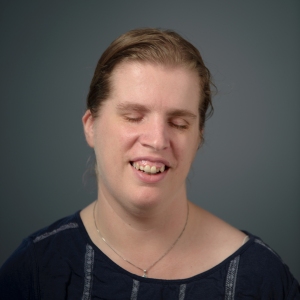Encountering disabilities can trigger a range of uncomfortable emotions. Many people have not witnessed humans with disabilities living enriching lives, and many of us fear losing our temporarily able-bodied or temporarily ablebody-parted status. Becoming aware and acknowledging these and other emotions that may be unconscious blockers to employment for people with disabilities is crucial.
When faced with discomfort, people often resort to two equally problematic types of responses.
The first type of response is disengagement or inaction. On the street, this might mean looking away from a person who seems different, discouraging children from bringing up questions, even in private, or, as an employer, moving past a job applicant with a disability and quickly sending out a form rejection — or far worse, not responding at all.
The second type of response is taking problematic action. This could look like seeing a blind person walking down the street, fear for their safety, and grab them while stating you will help them across the street. That action, however well-intended it may be, deprives the person of agency in that moment. As an employer, you could act problematically if you decide to interview an applicant but “know” they will not get the job, because they have a visible disability.
The biggest issue with these types of responses is that any of them could come from a place of good intentions. Turning away could mean avoiding doing or saying something to hurt someone’s feelings, just as not interviewing someone could help you to avoid leading someone on when you “know” they don’t fit your idea of the ideal applicant. Helping someone without asking could mean you care about keeping them safe, while giving them a token interview can mean you are giving them the opportunity to “practice” the interview process but hoping someone else will eventually hire them.
As an employer, you are seeking connection with each applicant, whether you are together for a half an hour or someone’s entire career.
Brené Brown might classify these responses as sympathy rather than empathy: “Empathy fuels connection. Sympathy drives disconnection.” When you act out of a place of sympathy, you exist above the people you help in a place of privilege that you have made up your mind not to transcend. You might help these people if they are in trouble — which you might subconsciously think they are, because they have something “wrong” with them – but you exist in a different community. You might interview them but never work with them.
The way forward is mindful action, or action that comes from a place of empathy. Instead of taking a role of superiority while someone with a disability is victimized, using mindful action begins with the assumption that you are both human and therefore at least on the same plane.
As an employer, mindful action would then mean that you approach each applicant with openness and curiosity and that you recognize that every applicant, whether they ultimately get the job or not, has something in them that is like something in yourself. You are seeking connection with each applicant, whether you are together for a half an hour or someone’s entire career.
Below I’ll outline ways to do that in the different phases of the application and hiring process. The examples I’ll use to illustrate my points will primarily come from the blindness community, as that is the community with which I have the most familiarity. While different disabilities offer unique considerations as employers provide accommodations, and while no two individuals with the same disability present in the same way, these examples are general enough to transcend across disability experiences.
Reading application materials: Experience is experience
Let’s say you come across the resume of an unknown applicant, and you read that she held a leadership position in a blindness advocacy group, or that they write a regular column in a blindness-related newsletter. You might think to yourself, “A blindness group, and/or several blindness groups — this person might be blind.” You might also think, “This has nothing to do with X job in my company. That experience will be easier, or different, than what I’m asking of this applicant.”
But aside from the specific issues of an organization, the position is the position. Whether blind or sighted, a leader in the organization is still responsible for accomplishing goals, deciding which responsibilities to take on and which to delegate, and navigating the same organizational drama that people with any leadership position navigate. A writer is still responsible for researching the topic, setting out the vision, revising, and then possibly revising again based on feedback from the team.

At work. (Photo by Mikhail Nilov from Pexels)
The skills this experience brings to your table are similar to those skills people in any other special interest group bring, along with the additional skill of adapting to and overcoming accessibility hurdles. Identifying possible transferrable skills is a skill that not all hiring managers take the time to consider. Asking about these is exactly what an interview is for. It’s important to reserve judgment whenever possible, unless the job requirements are concrete, and the applicant does not meet many of them.
There are even some requirements which may be suspect upon further examination. Let’s take a driver’s license requirement that appears on many standard applications as a prime example. This requirement shuts out people with disabilities who could use public or private transportation to get where they need to go. Does this requirement need to be included for this position? Often requirements like these are carried over from position to position without any idea that they may be excluding whole segments of the population. If you are fairly certain that the applicant before you can’t drive but has applied for your driver’s license-requiring position, it is possible that that person has a solid backup plan for leaping this questionable hurdle.
Think expansively as you decide whom to interview, assume that your applicants (usually) know what they are doing when they apply, and keep your slush pile smaller and your list of possibilities larger.
Interviewing: Leave room for applicants to demonstrate their best selves
By now we hope you have the desire to think openly and to learn more about each applicant who seems potentially qualified for your job, but you may feel hampered by the traditional interview process when trying to put any concerns you have about a disability to rest.
A best practice for employers is to ask reasonably similar questions of every applicant to fairly gauge responses across applicants. It is illegal for an employer to ask if someone has a disability or elicit information meant to disclose a disability. Even if it is visible or comes up in a follow-up question or discussion to an individual , the employer still can’t directly ask an applicant how a disability will impact their work. This puts the onus of proving that they can work fully on the prospective employee, and furthermore, if disability does not come up as part of the discussion, an interviewee may feel incredibly awkward and uncomfortable inserting it into a conversation.
A prospective employee may or may not bring up their disability. That’s fine.
Life is not on “the disability channel” for people with disabilities, and disclosure is an individual preference based on the degree of the disability and the applicant’s previous life experiences. But even if a person feels that disclosure is comfortable or necessary, and if that person has been coached about when and how to do it, inserting it can still feel odd. We do not advocate going back to “the beginning” when people with disabilities applied for jobs before there were laws to protect them, as questions about a person’s differences can be extremely uncomfortable for everyone involved.
However, there is a way forward. Don’t simply ask an interviewee during the last 30 seconds of the interview if the person has any questions. Most likely they do have questions, but this is a time to discuss the actual requirements for the position. Once you have asked the key questions about the role and the individual has had a chance to talk about their experience and potential, I would encourage every interviewer to ask every interviewee, regardless of possible disability, something like, “Are there any questions I should have asked that you would like to answer?” This invites the applicant to bring up additional information, or perhaps the additional skills they’ve gained in a world that was not designed for them or their accommodations needs and allows the applicant a chance to control the flow of information once you both have established rapport.
A prospective employee may or may not bring up their disability. That’s fine. It gives people one additional opening besides the initial, overwhelming, loaded and scary “Tell me about yourself” question, in which applicants often want to make a first impression that does not involve their disability. This additional question gives them a new opening to bring up anything related to how they could succeed in this position.
Hiring the applicant
It has happened. Your applicant has crushed the interview. You’ve found the person who’s going to bring your company to the next level, and that person happens to have a disability. Now what?
First of all, reader, you hire them, or at least offer them the position with enthusiasm and humility, because they may be contemplating more than one.
Secondly, like about 99.9% of us, you probably have a disability that affects your ability to read minds. (That was not an official statistic.) So if you lack this crucial skill, do not hesitate to ask your “suspected” applicant, or any applicant, what accommodations they might need in order to bring their very best selves to the job.
Accommodations do cost money. If at all possible, funding them will go a much longer way than providing coffee. It will increase your diversity of perspectives and ideas. But let’s say you are a small startup company without much additional funding. Talk to your applicant to brainstorm ways accommodations can be funded. Or better yet, do your homework and look into it on their behalf. But always approach the conversation with the idea that accommodations will happen on time and that they are crucial to your company’s vision, not just to your applicant’s success. Remember, you just asked your applicant for the mind-reading disability accommodation.

At work. (Photo via Tamman/iStock)
Orientation and beyond
Perhaps subconsciously, many people, even those who regularly hire people with disabilities, approach the idea of orientation with the feeling that their new hire knows nothing about the company except your mission statement. But assuming your new employee has been around a few years, that person is also an expert on many things. Some things are unrelated to the job but still provided them the skills or life experience to now be your perfect candidate. Other things, like the person’s disability, are now very much related to the job, even if people wish they aren’t.
You may not know exactly how to orient a person to your office layout or interact with them on a daily basis. If you don’t, ask. Orientation is not just a chance for you to indoctrinate them into the ways of your company culture and to give them the nuts and bolts of the job; it’s really a chance for you both to have a dialogue, to get to know each other better, and to coalesce into a hardworking, successful, evolving team. Because who knows? That applicant with a disability whom you plucked from the slush pile may someday go on, if they haven’t already, to lead part or all of your company or another.
How can I find people with disabilities?
People with disabilities are literally everywhere. According to the CDC, 26% of adults in the United States, where I reside, have some type of disability. Because of that, every state has services for people with all types of physical, sensory or intellectual differences, and many of those services can connect you with transition programs, programs for high school and college students to connect them with the world of work.
Seeking out people with disabilities will help your company, it will help individuals, and it will help society as a whole.
For instance, the College Success Program, sponsored by Envision, gives college students all over the country who are blind or who have low vision mentors, resources, community connections, and access to internship and employment experiences. Reaching out to groups such as this one can give your company connections to important people, the next generation, to whom you can offer valuable work experiences that will make them ready for full-time employment someday. And that full-time employment may even be with you!
Hiring interns and moving them into full-time status is only one way to find people with disabilities, and using interns doesn’t mean that you’ve checked the box for incorporating disability diversity into your workplace. Remember, this does not cover people at mid-career or beyond.
Equitably including people with disabilities into your workplace is a struggle, even if you have deeply committed to it. Some people with disabilities do not want to disclose their disabilities, due to the biases we’ve discussed. Others may not realize their worth or be invited to participate in experiences that give them good potential to hold leadership roles. The laws which protect them and which we do not want to dismantle also contribute to hiding them in some contexts.
The list of challenges toward building a disability-inclusive culture is gigantic, and if you feel this is a struggle, you are not alone. But seeking out people with disabilities will help your company, it will help individuals, and it will help society as a whole. Look for professionals at all career levels, listen to their stories, and, to pun a little on President Kennedy, ask not what they want from you but what they can do for you!
Join the conversation!
Find news, events, jobs and people who share your interests on Technical.ly's open community Slack

Philly daily roundup: Student-made college cost app; Central High is robotics world champ; Internet subsidy expiration looms

Delaware daily roundup: Early-stage loan help; Jobless rate drops below 4%; $700k grant for industrial park

Philly daily roundup: Earth Day glossary; Gen AI's energy cost; Biotech incubator in Horsham


